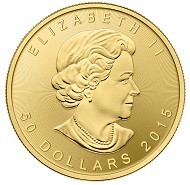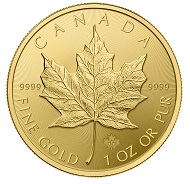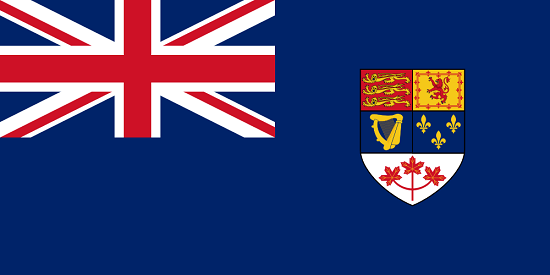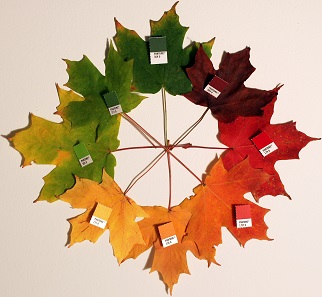translated by Christina Schlögl
The Maple Leaf was first minted by the Royal Canadian Mint in 1979. It is thus the second oldest bullion coin. In contrast to the 22 carat Krugerrand, it was 24 carat from the very beginning and was therefore designed with the highest possible purity. In the year 1988, the Canadian mint utilised its technological advantage, raised the purity to 99.99% and used this technological pioneering feat for an extensive marketing campaign. In 2007, the purity of the Maple Leaf was increased once more, reaching 99.999%. The customer gets the highest purity possible but the physical constitution of gold – pure gold is very soft – offers a problem. The Maple Leaf is very susceptible to scratches and edge nicks. Those however do not lower the value of bullion coins.
The Canadian Maple Leaf in gold. It has existed since 1979. Photo: Royal Canadian Mint.
Rise of the Krugerrand
Anyhow the mintage of the Maple Leaf quickly rose, especially because of the import ban on the Krugerrand in the EU and the USA. It became the most popular bullion coin worldwide, which was also influenced by the Royal Canadian Mint being one of the first mints to establish a systematic marketing and worldwide sales and distribution. Since then, mintage often exceeds one million per year. The Royal Canadian Mint is proud to have sold more than 25 million ounces since 1979.
Since 1982, the Maple Leaf is also available in the denominations 1/4 and 1/10 ounce, 1/2 ounce since 1986 and 1/20 ounce since 1993. Between the years 1994 and 1996, there shortly was a 1/15 ounce coin, which was not successful and was therefore discontinued.
Today, the authenticity of a Maple Leaf can be tested as quickly as lightning using a small device. Photo: Royal Canadian Mint.
The Bullion-DNA
In order to protect customers from forgery, the Royal Canadian Mint has developed a safety-feature, which they call Bullion-DNA. It is based on a micro intaglio, neither visible for the naked eye nor under magnifying glass. The dies show different micro intaglios which are changed quickly and which are archived on the servers of the mint. Whoever wants to test a gold coin, will need a special device, made by the mint and internet connection. The device takes a high definition photo of the micro intaglio and transfers it via a computer program linked to the DNA-server of the mint. In a fraction of a second, the program matches the safety feature of the tested coin with the pieces on the server and thus quickly reaches a result.
The Canadian Flag. Photo: Jared Grove / https://creativecommons.org/licenses/by-sa/3.0/deed.de
The design: Under the sign of the maple leaf
The Maple Leaf has got its name from the maple leaf, depicted on the obverse. The maple leaf is “the” national subject of Canada, which we can also see on the Canadian Flag.
However, this is not as self-evident as we might think today. When the Maple Leaf was first minted, the Canadian flag was less than 15 years old. And it had been highly controversial when it was introduced.
Precursor to the Canadian flag until the year 1965. It not only depicts the red maple leaf, but also the French lily. Source: Iman0613 / https://creativecommons.org/licenses/by-sa/3.0/deed.de.
There had been fierce battles of words and even physical fights around the decision on a subject for the flag. The French Canadians would have loved to keep the French lily, which had been on the flag for centuries. But the Anglo-Canadians had a majority in the House of Commons. Thus the delegates accepted the new flag with 163 to 78 votes in 1964.
The leaves of the sugar maple change colour in all kinds of shades in autumn. Source: Chris Glass, edited by Jeff G / Wikipedia
By the way, the red of the maple leaf on the national flag is not as unrealistic as one might think. The sugar maple, widely spread in North Amerika (acer saccharum), is known for its gorgeous shading, ranging from yellow to brown to a bright scarlet.
Three portrait alternatives on the reverse
The reverse of the Maple Leaf depicts Queen Elizabeth II, designating Canada as a monarchy. Three alternative portraits have been designed for the Canadian Maple Leaf since its first mintage in 1979.
From 1979 to 1989, it showed a youthful portrait by Arnold Machin.
Considerately adjusted to her real age, an image of Queen Elizabeth, designed by Dora de Pédery-Hunt, was depicted from 1989 to 2003.
Since 2004, the Maple Leaf bears Susanna Blunt’s portrait of a mature queen without any royal insignia.
Queen Elizabeth II during a visit of Toronto. Source: Ibagli / 6 July 2010 / Wikipedia.
The Canadian monarchy
Due to historic reasons – after all the country did belong to the British Empire for a long time – the English king or queen is also monarch of Canada. While most of the sovereign rights are taken over by the Governor General, the Canadian monarch still has a series of rights and responsibilities.
Theoretically, Elizabeth II has the right to enter into international treaties in Canada’s name and send ambassadors. She appoints the Prime Minister, who is supposed to advise her and the Governor General on executive matters in Canada. It is merely an unwritten law that the chairman of the party elected by the Canadian majority is appointed Prime Minister. Elizabeth de jure can decide on matters of war and peace and she is Commander-in-Chief of the Canadian Armed Forces.
Her strong standing is mainly weakened by the fact that the queen does not use a lot of her rights. She ratifies the laws and contracts, the House of Commons and the Senate have negotiated, appoints public officials recommended by the politicians and only seldom interferes with political day-to-day business.
By the way, Queen Elizabeth only becomes an expense factor for Canadian tax payers when she is travelling in Canada or when she acts as a representative of Canada abroad. In that case, Canada pays the travel expenses, the costs for security forces, bureaus and ceremonies – there is no personal compensation or salary for her in the national budget.
In 2002, a public poll showed, how little Canadians are actually aware that they have a queen. Only 5% of those questioned, named Queen Elizabeth as the Canadian head of state. The majority of people were strongly convinced that the Prime Minister was the top of their nation – even if all Canadians pay in coins with Queen Elizabeth on the obverse. No wonder, there are no anti-monarchist tendencies in Canada. The queen so rarely intervenes with Canadian issues, that she is not even noticed.
In February 2011, the then biggest gold coin in the world was exhibited on the occasion of the Berlin exhibit “Goldgiganten” (gold giants). Here we can see the coin with Bernd Kluge, former director of the Berliner Münzkabinett, Beverly Lepine, Chief Operating Officer of the RCM and Ian E. Bennett, president and CEO of the RCM. Photo: UK.
The biggest gold coin in the world
From 3 May 2007 until 27 October 2011, the Royal Canadian Mint held the official record for producer of the biggest coin in the world. With a weight of 100 kg, a denomination of Can $, 1,000,000, a diameter of 53cm and a thickness of 3cm, this “coin” is really impressive. It was minted with a purity of 999.999 per mille.
Metal variants of the Maple Leaf
Since 1988, there is a silver variant of the Maple Leaf, a one-ounce coin with the same depiction, which also has a purity of 99.99. Between 1988 and 1999, the Royal Canadian Mint also issued a platinum Maple Leaf with a denomination of 1, 1/2, 1/4 and 1/10 ounce. In a rather small mintage, Canada brought out a palladium variant between 2005 and 2009.
Numismatic Data
Coin description:
Obverse: CANADA / 9999 – 9999 / FINE GOLD – OR PUR
Maple leaf, right of the stem: weight
Reverse: ELIZABETH II
Bust of the English Queen Elizabeth II with crown, underneath: denomination and year
Can $ 50 / 1 ounce / 999,9 / 31,103 g / 30 mm / 2,87 mm
Can $ 20 / 1/2 ounce / 999,9 / 15,552 g / 25 mm / 2,23 mm
Can $ 10 / 1/4 ounce / 999,9 / 7,776 g / 20 mm / 1,78 mm
Can $ 5 / 1/10 ounce / 999,9 / 3,110 g / 16 mm / 1,13 mm
Can $ 1 / 1/20 ounce / 999,9 / 1,555 g / 14 mm / 0,92 mm
Here you can visit the Royal Canadian Mint.
All episodes of the bullion coins series are available here.













